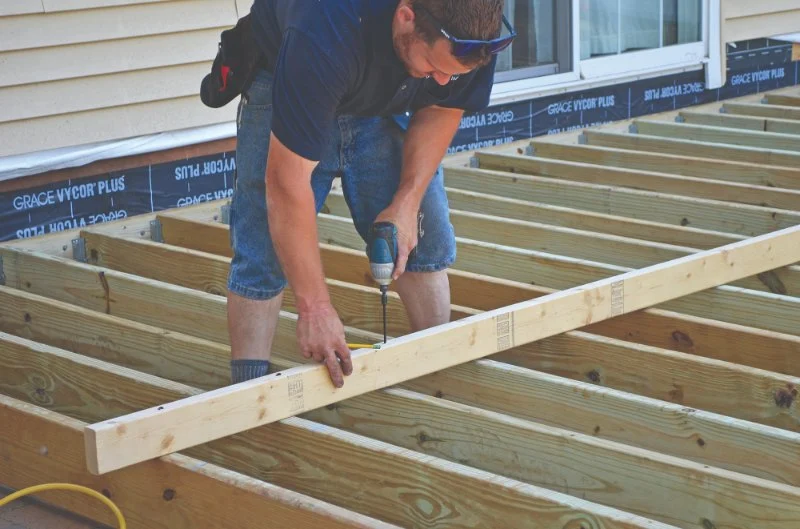
How to Block Pest Entry Around Deck Joists
- 1. Understanding the Risk of Pests Around Deck Joists
- 2. Types of Pests Targeting Deck Joists
- 3. Methods to Block Pest Entry Around Deck Joists
- 4. Best Materials for Sealing Deck Joists
- 5. Real-Life Examples and Success Stories
1. Understanding the Risk of Pests Around Deck Joists
Deck joists, the horizontal beams that support the deck, are often overlooked when it comes to pest prevention. However, these areas are prime locations for pest entry, especially if there are gaps or cracks around the structure. Pests like termites, ants, and rodents can easily access these spaces, leading to potential damage and infestations. Since deck joists are typically located in areas that are difficult to reach, they often become the perfect hiding spots for pests looking for shelter, warmth, or food.
Properly sealing deck joists is critical in preventing pests from invading your home through these entry points. This article explores effective strategies to block pest entry around deck joists, keeping your deck and home safe from unwanted pests.
2. Types of Pests Targeting Deck Joists
Several types of pests are drawn to deck joists because of the sheltered environment they provide. Here are some common pests that may target deck joists:
- Termites: Termites are one of the most destructive pests that target deck joists. These wood-eating insects can cause extensive damage by feeding on the wooden beams, weakening the structure of your deck over time.
- Carpenter Ants: Like termites, carpenter ants are attracted to wood. While they don’t eat wood, they hollow it out to create nests, which can also lead to significant structural damage if left untreated.
- Rodents: Mice and rats are notorious for squeezing into small gaps around deck joists to nest in hidden areas. Once inside, they can cause damage to insulation, wires, and even chew through wooden beams.
- Beetles: Various species of beetles, such as powderpost beetles, can infest wooden deck joists and cause deterioration by laying their eggs in the wood. The larvae then feed on the wood, weakening the structure.
- Wasps and Hornets: Deck joists, especially those under overhangs, can serve as ideal locations for wasp and hornet nests. If left unchecked, these nests can become large and pose a safety risk for anyone using the deck.
3. Methods to Block Pest Entry Around Deck Joists
To effectively block pest entry around deck joists, it's essential to take proactive measures. Below are some proven methods to seal off these areas and prevent pest intrusions:
- Install Pest-Resistant Screens: One of the simplest methods is to install fine mesh screens around the deck joists. These screens prevent insects, rodents, and other pests from gaining access while allowing for proper ventilation.
- Seal Gaps and Cracks: Inspect the areas around the deck joists for gaps or cracks where pests might enter. Use caulk or expanding foam to seal these openings. Be sure to focus on areas where wires, pipes, or other structural elements meet the wood.
- Use Pest Barriers: Consider using physical pest barriers, such as metal flashing or mesh barriers, around the deck structure. These barriers act as a physical shield to keep pests from accessing the underside of the deck and its joists.
- Regular Inspections: Regularly inspect the deck and surrounding areas for signs of pest activity. Look for droppings, damaged wood, or visible entry points that may indicate an infestation. Early detection allows for faster treatment and prevention.
4. Best Materials for Sealing Deck Joists
Choosing the right materials to seal deck joists is crucial in ensuring long-term pest protection. Here are some of the most effective materials for blocking pest entry around deck joists:
- Caulk: For small cracks and gaps, high-quality caulk is a simple and effective option. It can be used to seal around deck boards, posts, and joists, preventing pests from entering through tiny openings.
- Expanding Foam: Expanding foam is ideal for sealing larger gaps and holes around deck joists. It expands as it dries, filling in gaps and providing a barrier against rodents and insects.
- Mesh or Wire Screens: Galvanized wire mesh is an excellent choice for creating barriers around deck joists. It’s durable and allows for air circulation while keeping pests out.
- Metal Flashing: Metal flashing, particularly around the base of the deck, is a great way to prevent pests like termites from reaching the wooden structure. It is highly effective at blocking entry points and is resistant to damage from the elements.
5. Real-Life Examples and Success Stories
Several homeowners have successfully implemented these pest prevention strategies to protect their decks. For example, a homeowner in a rural area used metal flashing and mesh screens around their deck joists to prevent rodents and insects from entering their deck. After several months of regular inspections, they noticed a significant decrease in pest activity.
In another case, a beach house owner in a coastal area dealt with persistent termite problems in the deck joists. After sealing all gaps and installing pest-resistant barriers around the joists, the homeowner successfully prevented termites from entering the deck, saving thousands in potential repair costs.
These examples show how effective proper sealing and pest-proofing techniques can be in preventing pest intrusion around deck joists. With the right materials and maintenance, your deck can remain pest-free and structurally sound for years to come.
For more expert advice and the best pest control products for your deck, visit PestControlHub, where we offer a range of pest prevention solutions tailored to your needs.








 Wildlife Resolutions4.0 (443 reviews)
Wildlife Resolutions4.0 (443 reviews) Pest Marshals of Toledo5.0 (2 reviews)
Pest Marshals of Toledo5.0 (2 reviews) LS Rodent Proofing & Pest Control Service5.0 (4 reviews)
LS Rodent Proofing & Pest Control Service5.0 (4 reviews) Best Termite & Pest Control4.0 (16 reviews)
Best Termite & Pest Control4.0 (16 reviews) Varment Guard Wildlife Services5.0 (28 reviews)
Varment Guard Wildlife Services5.0 (28 reviews) Pestban Inc4.0 (394 reviews)
Pestban Inc4.0 (394 reviews) How to Use Monitors to Detect Pest Entry: A Comprehensive Guide
How to Use Monitors to Detect Pest Entry: A Comprehensive Guide How to Predict Which Pests Will Invade Next – Smart Pest Forecasting for the U.S.
How to Predict Which Pests Will Invade Next – Smart Pest Forecasting for the U.S. How to Conduct a Pest Risk Assessment at Home – Expert Guide
How to Conduct a Pest Risk Assessment at Home – Expert Guide How to Block Pest Entry Around Deck Joists: Effective Solutions
How to Block Pest Entry Around Deck Joists: Effective Solutions How to Safely Use Fumigation Methods: A Comprehensive Guide for Homeowners
How to Safely Use Fumigation Methods: A Comprehensive Guide for Homeowners Why Pests Are More Active After Rain: Understanding the Link Between Weather and Pest Behavior
Why Pests Are More Active After Rain: Understanding the Link Between Weather and Pest Behavior